Bhuj to Bhuj (via Mandvi, and Kutch villages) - Sun 7 - Sat 20 Feb 2010
Mandvi is only 60km away from Bhuj but feels like a different world being surrounded by tropical beaches. Established in the 16th century it was once a major harbour and it remains a big centre for wooden ship building - one of only a few in the world. The immense ships are sailed across the Arabian Sea to be sold in the Middle East.
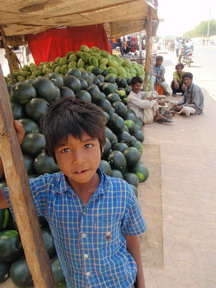
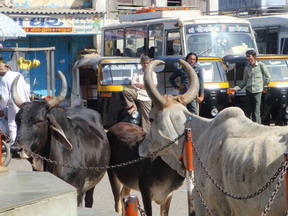
We had a quick look around the bustling little town but then headed out 8km or so towards the Vijay Villas Palace. This stunning beachside palace was built as a seaside retreat by the local Maharaja (whose family still owns it) in 1927 on the edges of a pine plantation he established. It had various rules on display such as no horn blowing and (quite reasonably!) no fire arms or spitting and they seemed to be working as the large crowd were all behaving themselves!
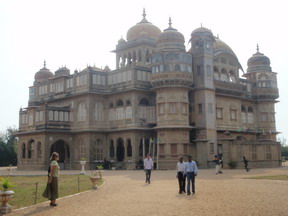
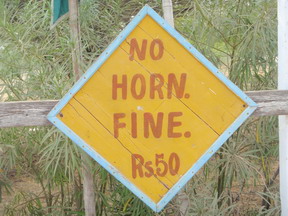
Nearby and also owned by the Maharaja is "The Beach" an up market tent resort and restaurant. The palace has been used as a setting in a few Bollywood smashes and is an impressive European style building with a really good roof top viewing area right over the Maharaja's private royal beach. This is now used exclusively by the resort's guests and any passers by who pay 100 rupees for the privilege which effectively keeps out any riff raff!
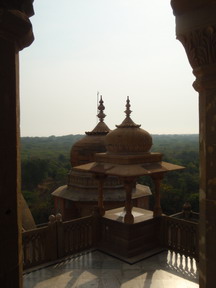
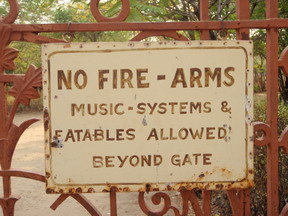
We had had a good heads up on a camp site here from our German overlander friends Kari and Walter whom we had met in Kathmandu Nepal. Thus we headed away from the palace grounds - pausing to admire the deer who charged over to get my proffered biscuit nearly getting in the car with me! - and towards a small nearby Shiva temple.
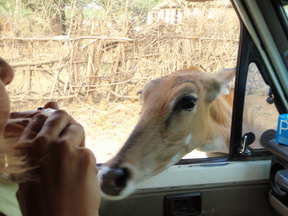
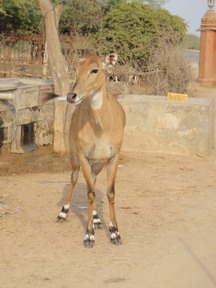
Kari had drawn us an excellent little map and we quickly found the little hill side temple where they had camped. She hadn't mentioned the resident guru but he (or actually one of his visiting disciples) came over and said that we'd be very welcome to stay there as long as we wanted.
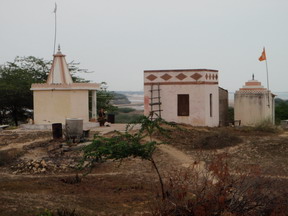
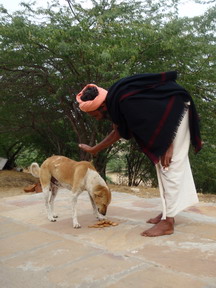
The guru spoke no English but through passing interpreters and by sign language we established he'd been up at his temple for 3 years. He was a nice guy, a heavy smoker which we didn't expect for a guru but he had a very nice calming ambience. We got into a routine where we'd go up and have a cuppa with him most afternoons and take him fruit as a gift. He was very kind to animals having a few temple dogs and we quickly befriended these too - especially "Cross Paws" our favourite - and they did a great job guarding the car!
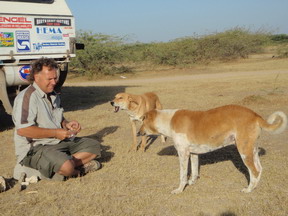
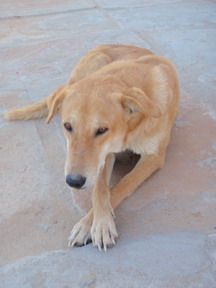
The only down side was that the entire area was inundated with the gando baval - which translated very appropriately as "the crazy thorn tree." Initially introduced in 1980 by aerial seeding in an attempt to stabilize the sand dunes this awful plant has spread throughout the region and is a serious pest. It was a nightmare if you trod on it barefoot and we were always nervous of getting a thorn in the car wheel. Nevertheless we braved cutting a path through to find our own private beach - just a bit away from the private resort one and free to use! We survived the experience with a few nasty scratches. The beach was lovely and clean and except for the odd fisherman totally deserted. The weather was fine and sunny though it was a bit nippy for swimming- and chilly at night - good sleeping weather!
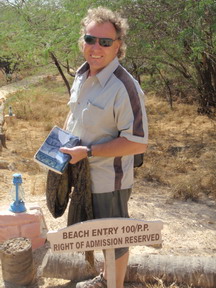
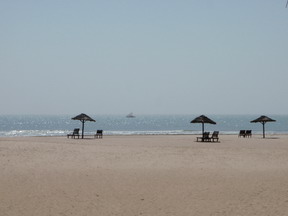
For the week we camped at the temple we often had dinner at the Beach Resort. This was a very high end set up with spacious tents with ensuite bathrooms and a great open air beachside restaurant. The manager Mr. Rajendra Singh was really accommodating and offered us a camp spot in the resort. On the whole we were happy at the temple, though we did move for one night when it was a festival to celebrate the god Shiva's wedding and there was a major shindig happening at our little temple! In town there was a spaced out looking dressed up Shiva collecting money and someone told us the custom was to drink home brewed liquor at the temple on this day so we felt we might not get a good night's sleep!
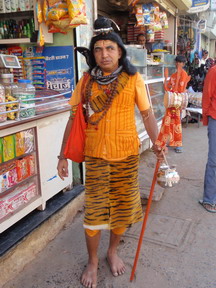

The Beach had a lovely setting and would be a great spot for a break have a look at their site www.mandvibeach.com The area was a hub of wildlife activity and we heard jackals each night and saw them a couple of times, we also saw a hedgehog and the local mongoose on many occasions. The mongoose was almost like a pet and the staff fed him sugar. He interacted well with the local puppies and seeming to think he was one of the pack! We also saw a swarm of bees busy making honey at the resort.
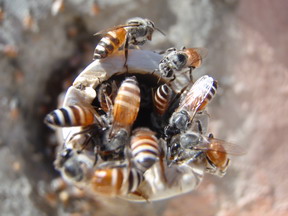
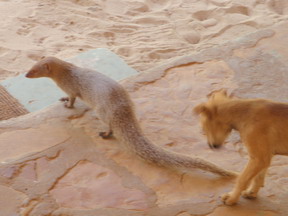
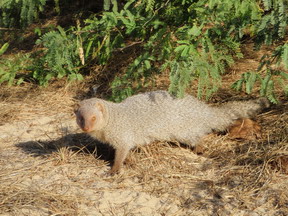
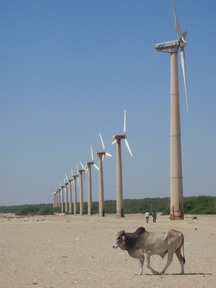
The area has a lot of windmills wind generation being big business here and we saw plenty at the town beach.
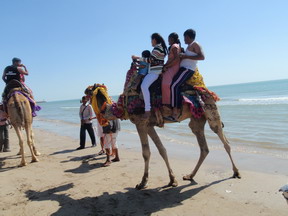
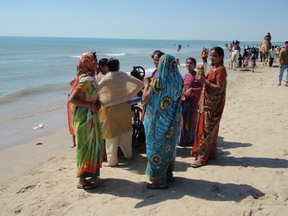
We visited this on a Sunday afternoon and it was a stark contrast to the resort's private beach being alive with Indian tourists and vendors selling anything /everything alongside camel and horse rides. A real Indian holiday scene - very full on!
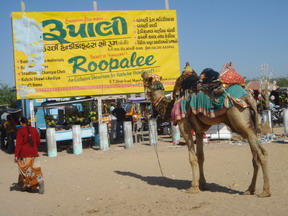
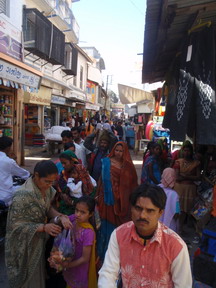
We also took a trip out 6km to have a look at a Jain temple we'd spotted on the way in. As mentioned before Gujarat is the state where most of the (often very wealthy) followers of this religion live and they are big on honouring their 24 gods with temples. This one constructed in the 1980s was very elaborate. There is a statue of their number one god in the middle of the temple and once a week he is dressed up in a specially designed outfit the base of which is solid silver and covered in flower petals. We had hit the right day (Sunday) and we saw the lady in our picture preparing the outfit which was hung on the statue - sadly no pictures of this allowed.
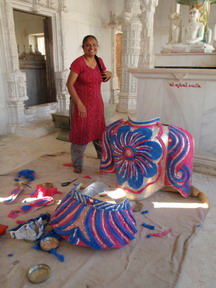
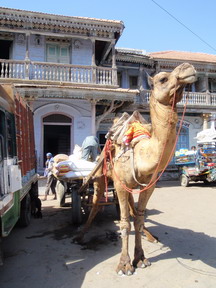
Finally before leaving Mandvi we had a good look around the boat yards. The harbour area was very dry but there was a wealth of ship building going on - 25 ships being worked on on the day we were there.
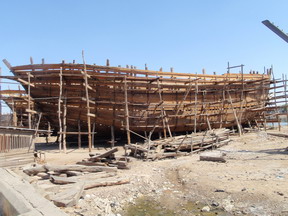
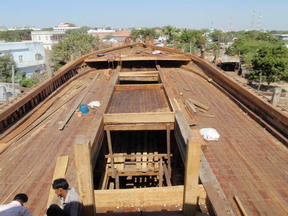
The boat builders didn't have much English which was a shame for Andrew as he'd have liked to have a real talk to them but they were very happy to show him around. As I said this is one of the few places left in the world which has wooden ship building using the old traditional techniques so it was great that it was kept alive. Interestingly the wood used is imported from Malaysia at a port just up the coast - the only one in India licensed to import wood.
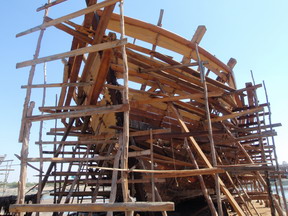
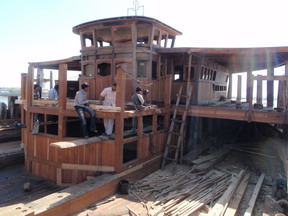
Maybe it was as well it was a bit too nippy to be really good beach weather or we might be in Mandvi to this day but on Monday 15 February we finally waved goodbye to Mandvi (and to any beach for the foreseeable future!) and with fuel and water fully restocked we headed off into the wilds of Kutch.
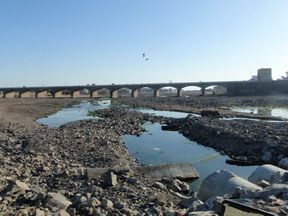
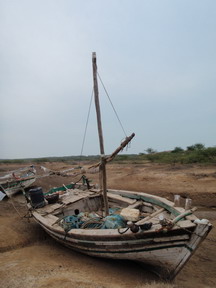
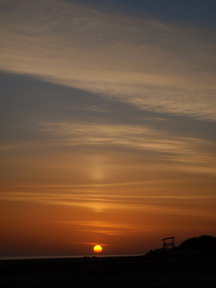
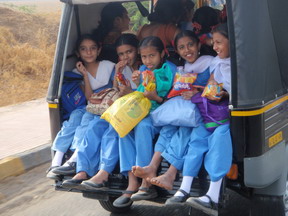
First stop was the small town of Tera. As an aside the tourist information on this whole area is a bit hit and miss. The LP covers a couple of the main areas but no great detail is given and local guidebooks/maps are a bit sketchy - it's the first place we struggled a bit finding our way there being no signs in English and a lot of the maps being majorly inaccurate. Anyway allegedly Tera was a little town with a lakeside castle and some interesting Jain temples. This is what our book told us so we pulled up and asked where were the castle /temples and no one seemed to know what we were on about. Eventually we found a picture of the Jain temple inside showing some very impressive glass work, which worked better and we were quickly put in the right direction.
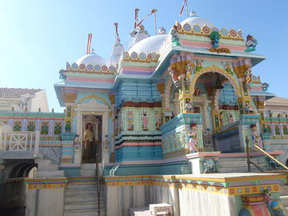
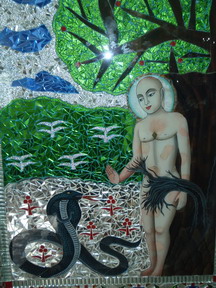
It was beautiful full of ornate painted mirror work and from the roof we got a view of the remains of the castle on the lake so we were able to track this down!
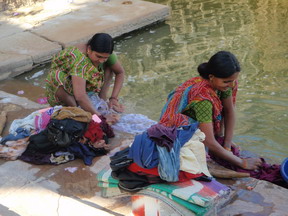
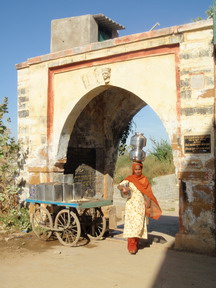
We enjoyed the atmosphere wandering through the narrow lanes around the thick fortress walls and seeing the local ladies scrubbing their washing down on the lake steps as no doubt their ancestors did centuries ago.

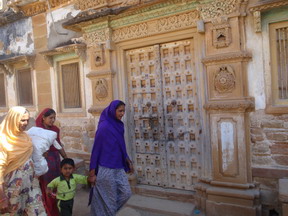
There was a lively market area with old men selling "medicine" in ominous looking bottles and lots of beautifully adorned tribal people which was really interesting.
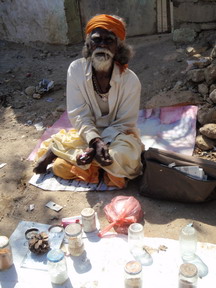
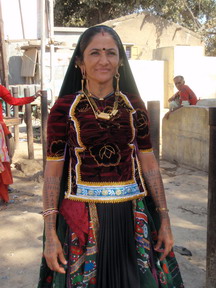
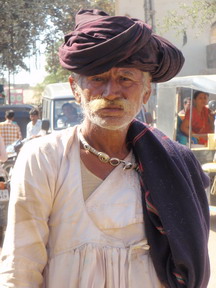
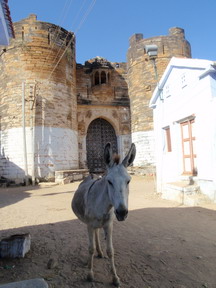
Our destination that night was the temple town of Narayan Sarovar (NS). This is one of 5 holy lakes in India (Pushkar in Rajasthan was one we'd already ticked off the list) and thus a huge site of pilgrimage for Hindus. In a time of great drought Lord Vishnu obliged the fervent prayers for water by kindly appearing and creating this lake with his toe. As in Pushkar bathing in the holy lake is sacred.
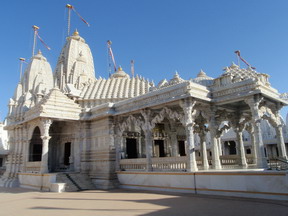
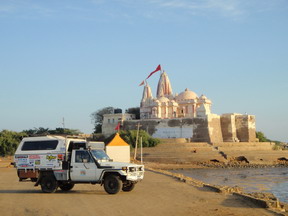
Just next to this is Koteswar temple a very ancient temple renovated in the 18th century and built to honour Shiva. It has a great view out over the water. Interestingly this is also the Western most point of India and you gaze out across the Arabian sea to where Pakistan lies just 24km away. Maybe for this reason there were police and border guards everywhere, though thankfully there hasn't been trouble here in many years. We asked where to park and were directed to the police station where the 2 resident policemen broke off from watching the cricket to make us very welcome.
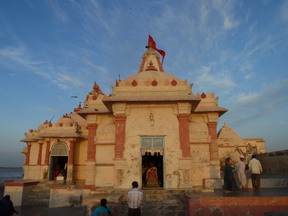
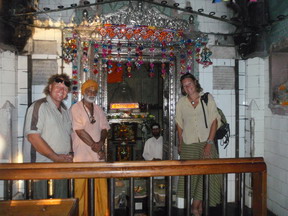
Then we went for a look around the temple. This was very full on. It had been quite a drive out to NS and we were well off the tourist track. As well as this a lot of the pilgrims had come by bus from small villages and maybe never seen westerners. Thus we were treated like celebrities which was a little overwhelming when you're hot dusty and tired. We must have had our picture taken by mobile over 1,000 times and both ended up with "air hostess face" syndrome aka "smile fatigue." We'll find it weird to be back home and be anonymous again! We had a look around the temple - no pictures inside- and at the somewhat murky sacred waters. There was a big crowd and a very lively atmosphere.
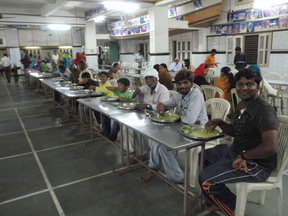
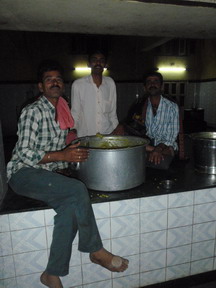
We headed off to find somewhere to eat and quickly found that the only place in town was the ashram -where you were served free meals of dal and rice from the huge communal kitchen and could stay for nothing. It was a really nice friendly atmosphere and we were made very welcome though being watched as I struggled to eat without using my left hand was a bit much. Afterwards we were invited to a room where a local TV star was performing for the masses - singling religious songs. It had been a long day and after 15 minutes or so we felt our heads start to nod which might have been awkward as our reaction to the entertainment was being filmed - so we made our excuses and left.
We were followed to the police station by a very well meaning crowd who were very worried about our sleeping arrangements and insisted we share their room "no money necessary." Finally we got rid of them and got to bed.
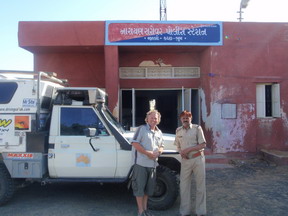
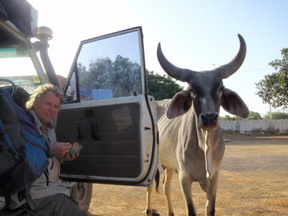
We slept really well - it was a great quiet spot and we felt refreshed next morning when we went and had a chat with the new policeman on duty who was also glued to the cricket! Over breakfast we got some hassle from a local cow. Being sacred and this a holy town she was used to being fed in the morning so she thought Andrew's full cereal bowl was an offering and had a good lick in there before he could stop her. He was not happy!!
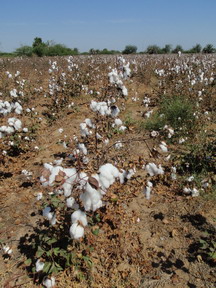
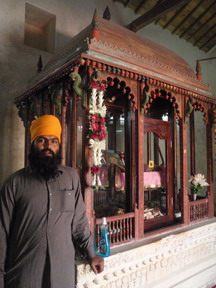
On we drove heading north. One of the major industries here (alongside salt) is cotton and we saw it growing everywhere, though apparently due to the last year's drought the crop is way down this year. Next stop was the remote ancient port city of Lakphat. This was once a major port until the 19th century earthquake diverted the river and turned it into a ghost town. Right on the north west edge of India the town is very close to Pakistan, at that time it was all one country and there was a wealth of trade with Karachi just across the water.
Now a hot dusty ghost town there are only a few temples, and Muslim tombs remaining. The area is also significant for Sikhs as their founder Guru Nanak camped here on his way to Mecca. The site of this house is now a Gurdwara or Sikh temple housing some of the great man's personal effects. The area is a site of pilgrimage run by a nice Sikh family who insisted we stay for lunch and were very upset we couldn't stay the night. We feel in demand up here!
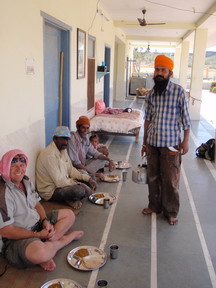
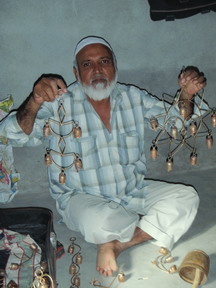
On we headed towards our next destination of Than. On the way we stopped to ask directions in a little town called Nirona and had a look at the local metal art of copper coated bells. We were approached by the son and taken to the family home where the work is done. It was incredibly labour intensive with 3 generations of the family involved. On we headed and saw the signs for the Infinity Resort which was very up market. The Manager Moti Meena was really welcoming and let us camp in their grounds- which was one extreme to the other - communal dining halls at the temple to 5 star dining. Having luxury tents and a central swimming pool this was a really great place and we'd recommend it for a relaxing stay - have a look at their sites www.campsofindia.com and www.palacesofindia.com Thanks to Moti and all his staff for making us so welcome.
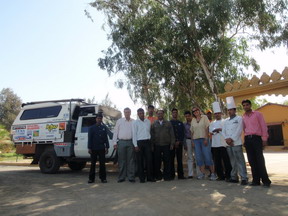
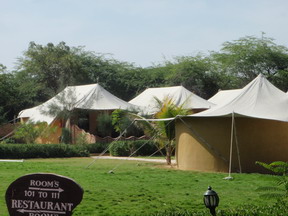
The reason we had come to Than was to see the monastery set in the hills. This site marks the spot where a holy man, Dhoramnath to make amends for a curse he'd placed on the town stood on his head for 12 years. The gods begged him to stop and he did on condition that the first place his gaze fell upon would be forever barren. He looked at the sea and it dried up hence the Little Rann. He then established the Kamphatas or "slit ears" order of monks. Interestingly these guys fled to Mandvi and we subsequently worked out that our own guru (see above) there was one of them. Rather than slit the ear is pierced in the middle in a way which must have have been very painful - I guess that's the point. Sadly we never got a close up shot of his ear to show you!
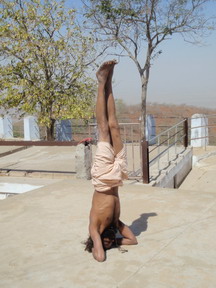

Anyway up we went in the intense heat 903 steps - a cinch compared to the 3,000 + we'd tackled in Palitana! At the top we received a cup of chai and a very warm welcome from the resident guru who insisted on standing on his head to illustrate the above story - though thankfully not for 12 years! The view out over the surrounding countryside was striking - very dry and barren.
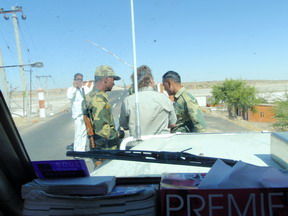
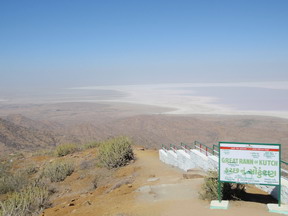
We then headed on to another viewpoint Kalo Dungar or Black Hill. This is on the road to the Pakistan border and we tried to go right to the edge but were turned back by the police, who seemed a bit suspicious of us though they let us go after a few questions. There is a steep climb up to Kalo Dungar and it is a renowned viewpoint which is why when we got there there were already a few coachloads -Indians and French - ahead of us. Legend says that a god once walked here and coming across a group of starving jackals he kindly provided his body for them to feed on, proving his godly status by continuously replenishing what they ate. Thus to this day the jackals are fed morning and evening. We'd just missed the first feeding but we did see a slow/low status jackal finishing up the crumbs! There was a great view - 400km x 200km - over the vast desert and salt plains - though sadly there was a fair bit of litter around. Bloody tourists!
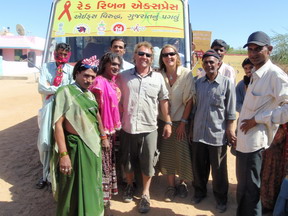
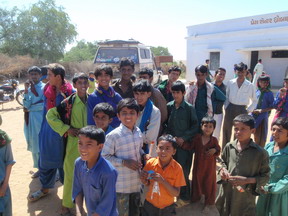
Driving on we came across a bus load of actors. No one spoke English but the bus had "AIDS" written on it so we guessed they were an awareness raising cabaret. They were very friendly and wanted to pose with us so out we got again! The 2 leading ladies were actually men. You meet all sorts out in the desert!
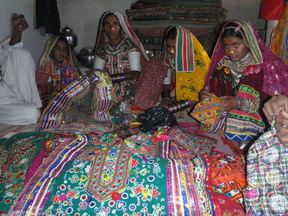
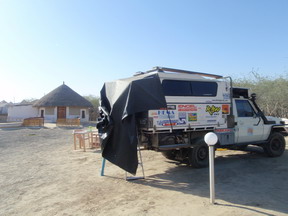
That afternoon we headed on towards Hodka a desert village which is the centre of a successful "endogenous tourism" project. There is a high end resort Shaam-e-Sarhad Rural Resort - which with the help of various NGOs is run and owned by the local Halepotra people. There were some nice rural style huts and a restaurant there but we weren't allowed to camp. There was heaps of room so we weren't quite sure why but as we were leaving a young man approached us and said we could stay at his village.
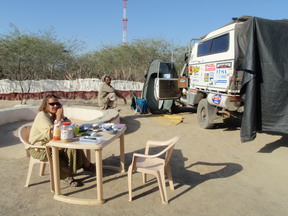
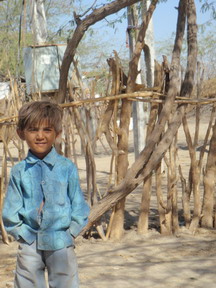
We followed him and arrived at a little settlement nearby with an indigenous village next to a row of "tourist" huts built in the same style. This was a new development. We were limited linguistically but gathered that the project had been set up with a lot of help from a French NGO and the lady of the house had been to Paris - which must have been an amazing experience for her coming from this remote area. There are several groups of tribal people in the area - many of whom came from Pakistan in the 1971 war - and they are all renowned for exquisite handicrafts. The people we stayed with here were (we think!) Harijans. The various tribal groups are diverse in terms of religion and specialist crafts but they all seem to produce wonderful embroidery. As an outsider it was hard to work out who was who as a lot of the clothing styles now overlap.
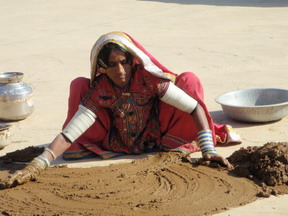
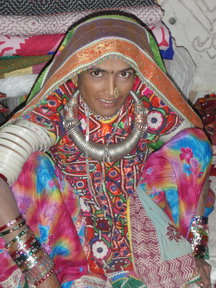
We camped in their compound and stayed with them for a couple of days and the experience was a real insight into living in a tribal village. The huts were very up market inside and everything was spotlessly clean. We actually thought you'd get more out of the experience here than staying in the more resorty Shaam-e-Sarhad which gets the bulk of the business mainly via travel agents as it felt more authentic. To stay here contact the son Premji (he has the most English) on (0) 9429810379.
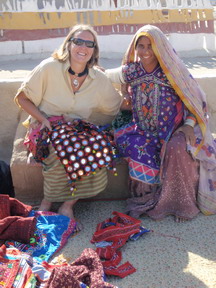
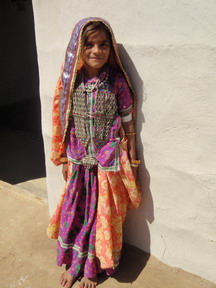
Whilst we were there we got to see some of the local handicrafts and though sadly we don't have much of a budget for this sort of thing we did buy a few little bits and pieces. Much of the work is done using pieces from old dresses and the attention to detail is stunning. Andrew was very taken with the mirrored "Disco Bag" but he resisted!
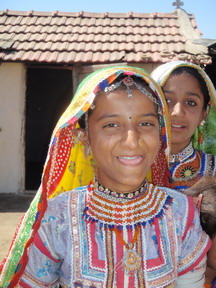
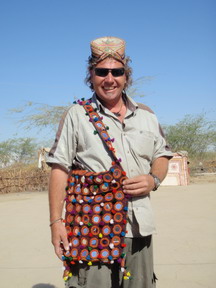
The huts which are in a compound surrounded by wooden fences which keep animals out are made of mud and inlaid with mirror work - a really attractive effect. The compound walls & floors are constantly repaired and refurbished using fresh mud. There had been a new arrival a few days before and I was invited into a ceremony (ladies and girls only) to welcome the new baby. There was singing and blessings and sweets were handed out and candles lit. Whilst I had no idea what was happening it felt really special to be included in this.
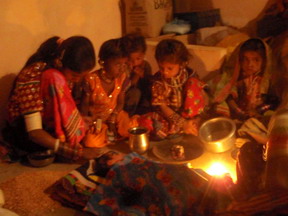
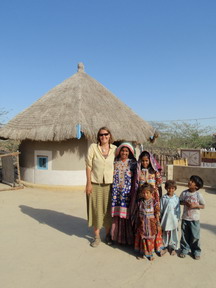
Whilst we were there we took a trip out to see Chhari Dhandh a nearby sanctuary which has over 2,000 species of birds. The father of the house came with us - it was all desert roads and no signage so we'd never have made it on our own! We arrived a bit late to see much birdlife but we did see the local camel herders who congregate around the water hole and we joined them for a cup of tea made with camel milk which was really good.
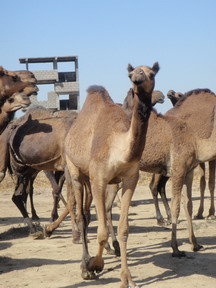
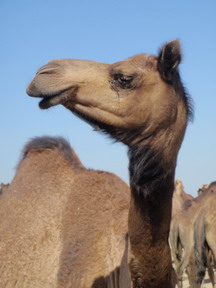
These people live a very simple lifestyle which hasn't changed overly in 1,000s of years. Even in winter the heat is intense out here and conditions must be pretty harsh.
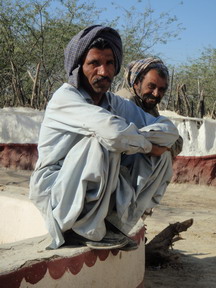
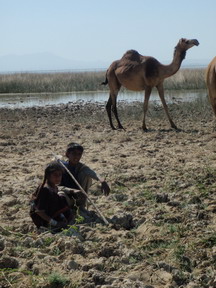
Afterwards we visited a nearby village of the Jat people to have lunch - the Jats are Muslim so mutton (which is goat here) was on the menu. In the afternoon we went and sat in the shaded tent and were served tea. It was all men and boys - I guess I got counted as an honoury man! Again life here is very traditional and it seems a bit incongruous when a turbaned shepherd in traditional dress stops and pulls out a mobile! They are very lovely people the children are quite beautiful and everyone is very welcoming though no English is spoken.
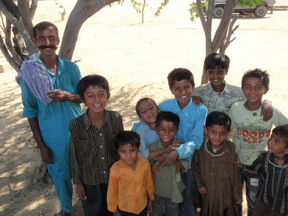
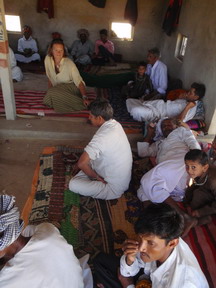
That evening as the sun set we drove out to a view point at the nearby white rann. The flat salt plains look like snow and are beautiful in the sunset. There was a (friendly) army checkpoint on the way in. We had to open everything up on the car to show them but it was more noisiness/interest than anything else!
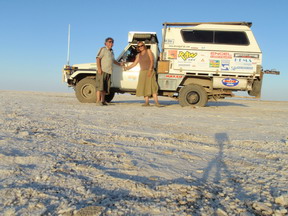
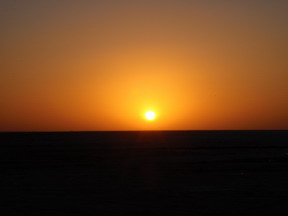
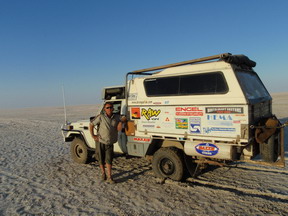
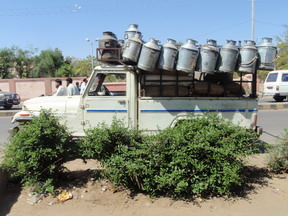
On Friday 19 Feb 2010 we drew back into the "bright lights big city" of Bhuj where we felt like we were coming home as we knew where to camp (the Hill Gardens)and where to eat (the Sankalp chain for a dosa ) so we felt like locals! We actually went into the Hill Gardens where we'd been camping outside and saw the fun fair, paddleboats (in their very grubby lake!) and the reconstructed whale skeleton there - all for the price of 2 rupees! It's a popular local attraction with a lot of weekend traffic. The Kutch area has many dairies and is a big producer of milk for all over India and we saw several well loaded milk vans out on delivery.
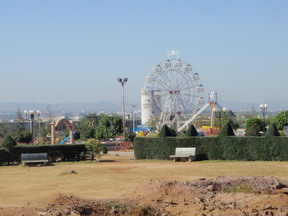
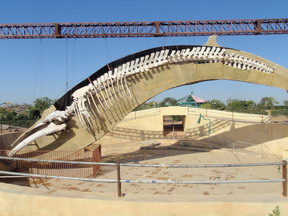
Whilst in Bhuj we stocked up on fuel and water and got to the internet - a bit scarce out in the villages! - before heading on. First we visited a local shop selling the Bhuj specialty of nutcrackers and pen knives.
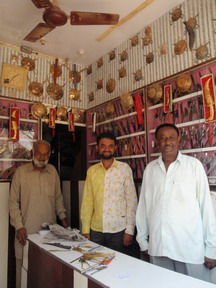
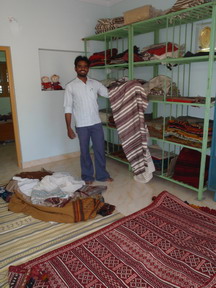
The makers of these articles (the shop we visited was 3rd generation) once made swords for the royal family of Kutch but over time they have diversified and knives and nutcrackers are now a popular gift from here. We left to the east of the city which was the area really hit by the 2001 earthquake. For this reason there has been a lot of investment here to try and improve the lives of locals by helping them develop their great strength of handicrafts. We passed through Bhujodi village which is renowned for weaving and visited a family of weavers who had some lovely handspun shawls. The award winning spinner was Mr. VH Aatubhai and he can be contacted on 9427566843 if you're interested in purchasing.
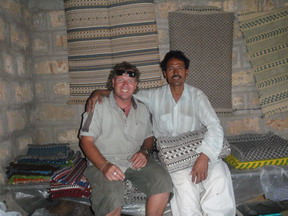
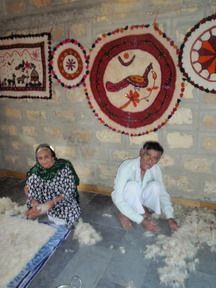
A great showcase of the arts in this area if you're too short of time to go around the villages was at the Hiralaxmi Memorial Craft Park. Here all the local artisans work to demonstrate their crafts - some of which have been lost but are now being recovered - and the completed goods are on sale. The artisans are given a free place to live and work for a month at a time whilst they make/sell their crafts and they come and go by rotation. As well as embroidery and mirror work there were several types of weaving, block printing, metal work and woodwork. We bought a rug made of camel and goat hair made using a once defunct technique called Kharad. Amazingly this craft is now performed by only one family in all of Kutch - that of the man in our picture. This technique is used for camel saddles and is renowned for being very hardwearing making it good for us! We also stopped briefly at the village of Anjar - supposedly a big centre for silver work though we didn't see much. This was maybe as well - it's my big favourite!
Lovely though they were we both felt we'd now seen enough handicrafts so we headed on towards our next destination - the Little Rann Wildlife Sanctuary -home to the rare Khur or Asiatic ass.
